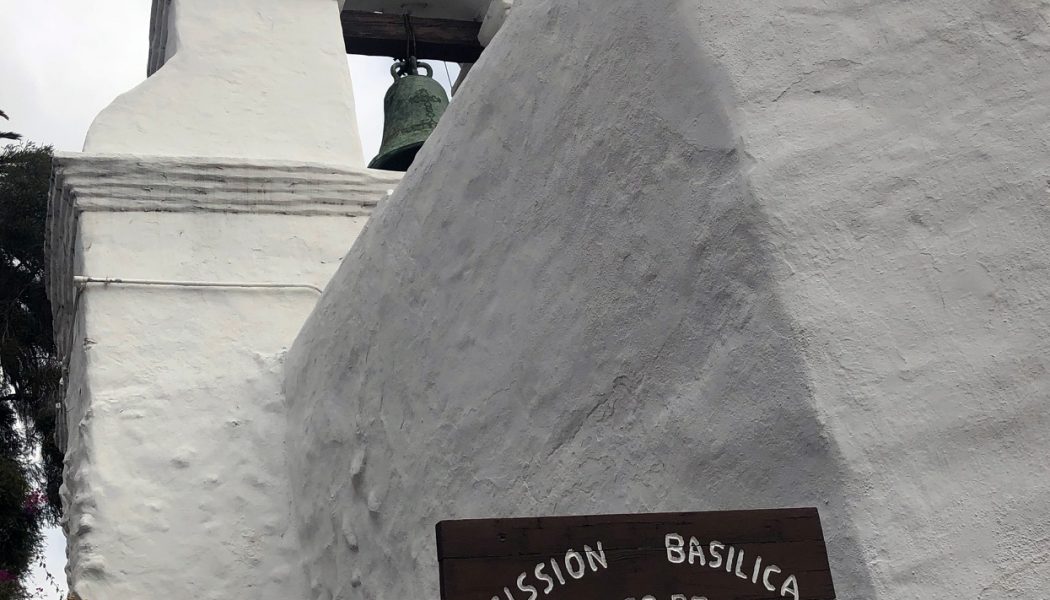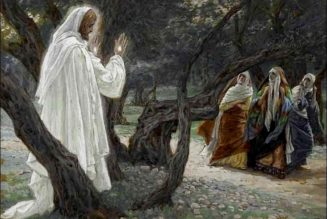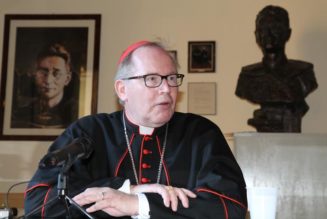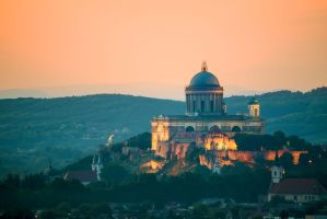ABOVE: Exterior of the Mission Basilica San Diego de Alcalá, with a statue of St. Junípero Serra. INSET: Exterior of the mission. BELOW: A model of the mission house where St. Junípero stayed; an example of native dwellings; a 19th-century photo of the mission; and photos of the interior and exterior of the mission. (All photos by Mark Armstrong)
St. Junípero Serra’s First Mission in California
St. Junípero, pray for us, that we will be filled with the same courage and love that you showed during your lifetime.
 In early March, my husband Mark and I visited Mission Basilica San Diego de Alcalá in San Diego, the first of 21 Catholic missions founded in California. It was established July 16, 1769 by the Spanish Franciscan friar, St. Junípero Serra (1713-84).
In early March, my husband Mark and I visited Mission Basilica San Diego de Alcalá in San Diego, the first of 21 Catholic missions founded in California. It was established July 16, 1769 by the Spanish Franciscan friar, St. Junípero Serra (1713-84).
During our visit, the coronavirus had not yet spread throughout the country, so life still continued as usual. By the time we returned home later that week, businesses and churches began to shut down. My plan to write about the mission as a travel destination suddenly seemed a bad idea. I would wait.
Now, four months later, St. Junípero is in the news due to the vandalism of some of his statues. Archbishop Salvatore Cordileone of San Francisco, performed an exorcism on the site where one was torn down on June 19. He called the actions “horrendous acts of blasphemy.” Amid so much confusion, it feels like now is the time to write about the mission and St. Junípero — perhaps not so much as a travel destination, but to consider what has gone before us.
Sainthood for the Friar
Mass at the mission for the second Sunday of Lent was overflowing so we stood just outside the open doors of the Spanish-styled stucco church as part of a crowd that spilled into the tiled courtyard. The Basilica, with its three-tiered bell tower, is a reconstruction of the original church built in 1813 and serves as an active parish today. One of the bells in the tower is original to the first church.
Mark and I spent time in the onsite museum and walked the surrounding garden with century-old hibiscus, olive, citrus and avocado trees. Historic recreations of a wooden cot and the quarters where St. Junípero stayed revealed a simple life. He and his Franciscan friars had traveled across the Atlantic Ocean from Spain to evangelize the native peoples of Mexico and California. This mission marked the birthplace of Christianity in the West Coast of the what would become the United States.
Fr. Junípero had established the first nine missions. He was to become our first Hispanic saint canonized on American soil by the first Hispanic pope, on Sept. 23, 2015. “Junípero Serra left his native land and its way of life,” Pope Francis said in his homily during the canonization Mass at Catholic University in Washington. “He was excited about blazing trails, going forth to meet many people, learning and valuing their particular customs and ways of life.” Pope Francis said that the saint “sought to defend the dignity of the native community, to protect it from those who had mistreated and abused it.”
There was, however, some contention at the time of the canonization. Aboriginal tribes in California protested Fr. Junípero’s sainthood in view of the fact that their culture had been disrupted. Today’s current violence is partly a continuation of that dissension and also an extension of protests from George Floyd’s May 25 death as a result of police brutality. Violent protests have spread onto St. Junípero’s mission field, identifying him not as a saint but as an oppressor.
St. Junípero came to baptize people and introduce them to Christianity at great personal sacrifice. Rioters see oppression, not courage and sacrifice. They do not see the propagation of Christianity to foreign lands as God’s work.
Human Rights Alongside the Gospel
According to the mission’s website, for thousands of years, the native people known as the Kumeyaay, lived in that area of California. By the late 1700s, Spanish explorers ventured into the territory to add to Spain’s land holdings. Since Russia and other foreign powers had their sites on this land, it seems inevitable that it was going to be occupied by one country or another. Alongside Spain’s political move, a religious mission sought to bring Catholicism. The friars were not the military. They had come not for wealth and power, but to spread the Gospel.
St. Junípero helped to convert thousands of native people to Christianity and taught them new agricultural technologies. The small bark tree huts that the aboriginal people lived in were primitive. They hunted, gathered fruits and nuts, and fished, but practiced little agriculture. The Spanish system was to bring agriculture, ranching, and Christ and a better life. Research into the life of St. Junípero that led to his canonization found him to be a champion for the rights of native people to the point of heroic sacrifice against sometimes harsh treatment from the Spanish. When he died at the age of 70 in 1784, there was an outpouring of grief by many of the native people, who referred to him as “el santo”— the saint.
None of these facts has ended the controversy, but in response to the toppling of St. Junípero Serra’s statues in San Francisco and Los Angeles, the California Catholic Conference of Bishops issued a statement.
“If this process is to be truly effective as a remedy for racism,” said the bishops, “it must discern carefully the entire contribution that the historical figure in question made to American life, especially in advancing the rights of marginalized peoples.”
The bishops expressed their wholehearted support for broad national coalition dedicated to eliminating racism against members of the Black and Indigenous communities. But they stand firmly behind St. Junípero, as one who did just that. “In working with Native Americans, he was a man ahead of his times who made great sacrifices to defend and serve the indigenous population and work against an oppression that extends far beyond the mission era.”
St. Junípero, pray for us, that we will be filled with the same courage and love that you showed during your lifetime. And please pray for peace in your adopted homeland and in the world.















